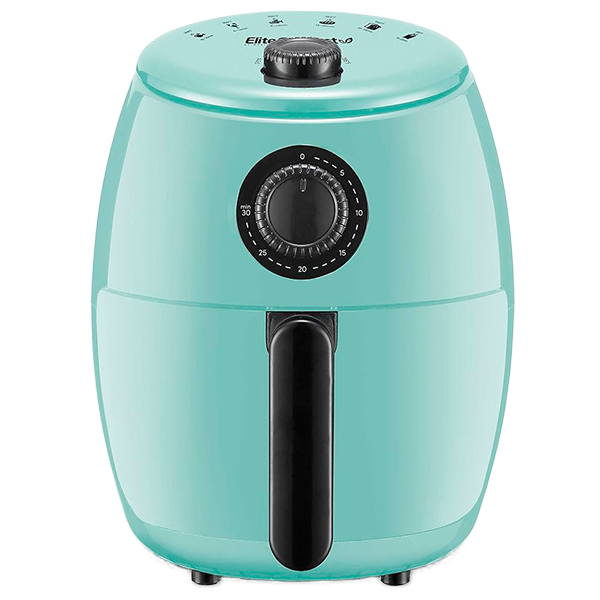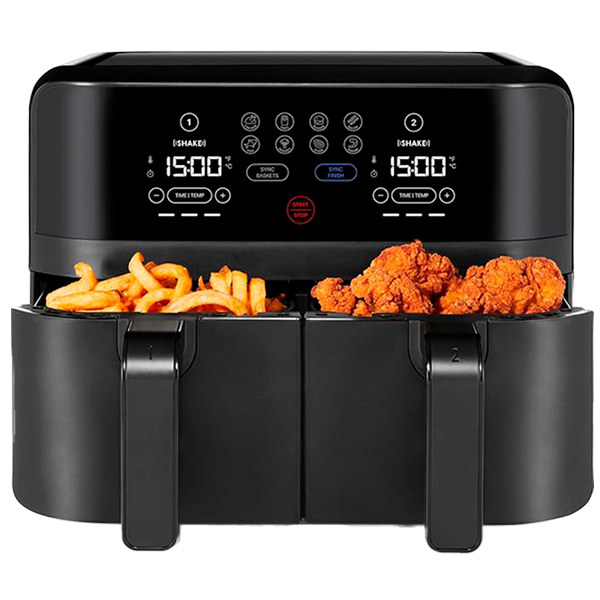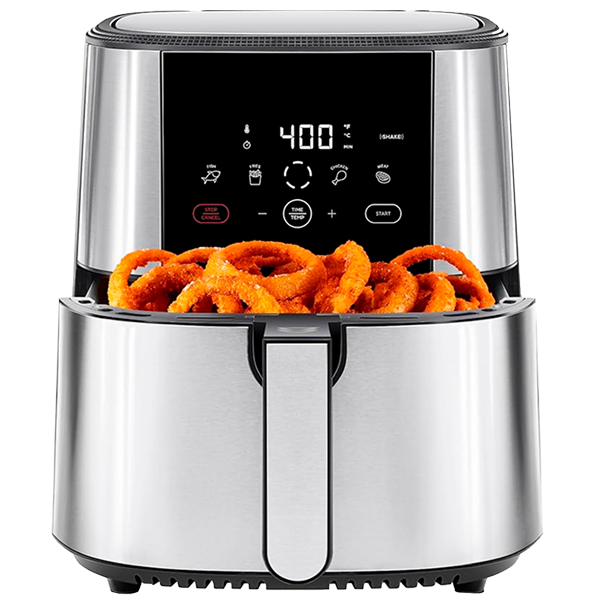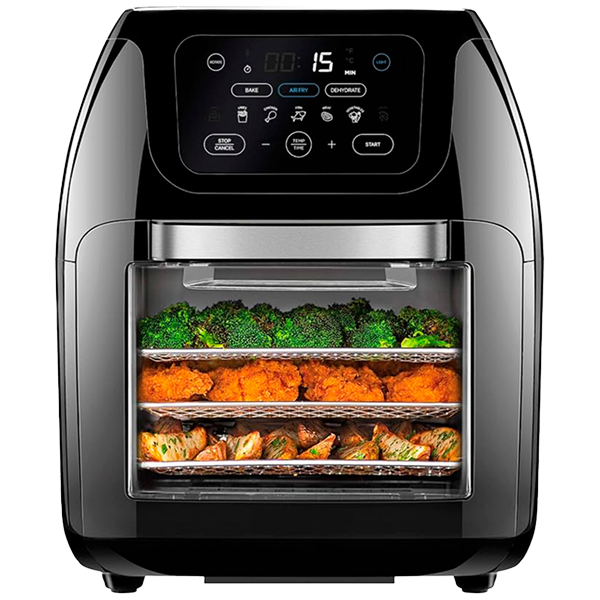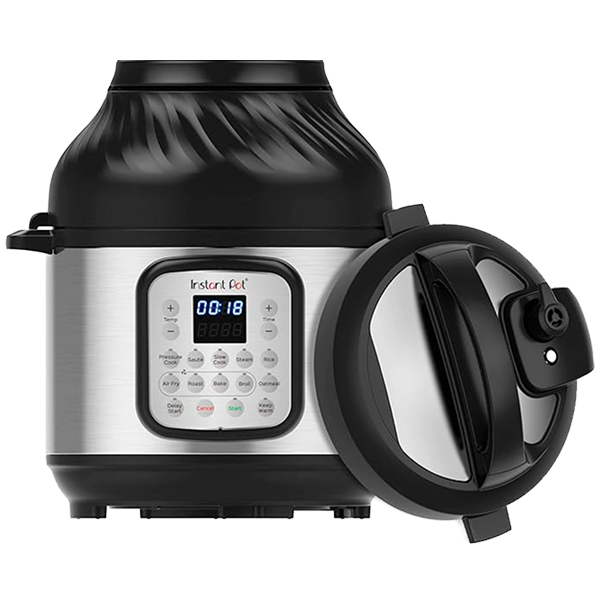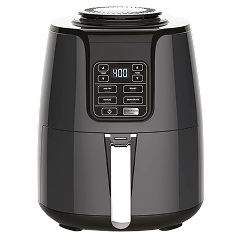Dual air fryers have quickly become one of the most practical upgrades in home cooking. With two independent baskets, they let you prepare different foods at the same time, whether that’s chicken wings and fries or a main and a side dish. This flexibility saves time, reduces the need for multiple appliances, and makes it easier to serve complete meals at once.
In this guide, we’ll break down the key features to consider when choosing a dual air fryer, from basket size and cooking functions to performance benchmarks and ease of cleaning. By the end, you’ll have a clear sense of what to look for and which models might fit your cooking style best.
How To Choose a Dual Air Fryer
Form Factor
Dual air fryers come in two main designs: basket-style and toaster oven-style. Both have two independent cooking zones, but they offer very different experiences.
If you want something compact and easy to clean, go with a basket-style model. The baskets slide out, and you can wash them in the sink or dishwasher. They’re best for straightforward meals and snacks where you don’t need to cook large portions at once.
If you often cook for a family or want to prepare multiple trays of food, a toaster oven-style model is the better fit. These allow you to stack trays in each compartment, meaning you could have up to four dishes cooking at once. Some designs, like the Ninja Double Oven, even give you a larger compartment on one side and a smaller one on the other for added flexibility.
You’ll also see two layout options: side-by-side and stacked (vertical). Side-by-side models are wider but fit under cabinets more easily. Stacked models save counter width but are taller, so check the clearance between your countertop and overhead shelves. As a benchmark, if you have less than 18 inches (46 cm) of space above your counter, a stacked model might not fit comfortably.
Capacity
Capacity is one of the biggest differences between models, and it’s worth matching this to your household size.
Compact dual fryers offer about 4 quarts (3.8 liters) per basket, giving you 8 quarts total. This is enough for a couple or a small household but can feel limiting if you cook large meals.
Mid-range models usually give you 7–9 quarts per basket (14–18 quarts total). These are well-balanced for families of 3–5 people and let you cook proteins and sides simultaneously without running out of space.
Large toaster oven-style models can reach 20–24 quarts total, often with multiple racks per compartment. With these, you can cook for a big family or even prep up to six different trays of food at once. The tradeoff is size: they can be twice as wide as basket models and weigh over 25 pounds (11 kg), so make sure you have the counter space.
Temperature Range
Almost all dual air fryers handle the basics—fries, chicken, frozen foods—without issue. Where they differ is in their temperature extremes.
If you want to dehydrate fruit, herbs, or jerky, look for models that drop to 130°F / 55°C or lower. Many air fryers bottom out at 170°F (75°C), which is too hot for dehydration.
On the upper end, most models max out at 400°F / 205°C, which works for everyday cooking. But if you want to broil, sear, or get extra-crispy results, choose a model that can hit 450°F / 233°C. That extra range makes a noticeable difference with foods like steak or baked dishes that need a browned top.
Wattage
Wattage measures the cooking power of an air fryer, and for most people it won’t be the deciding factor—but it does affect performance.
Small dual-basket models often start at around 1500 watts, which is fine for everyday use if you’re mostly cooking single trays of food. However, larger models usually step up to 1700–1800 watts, which gives them faster preheating and better consistency when both baskets or trays are running at the same time.
Anything below 1500 watts is worth avoiding, especially if you plan to use both compartments heavily or stack trays in an oven-style model. Lower power makes it harder to keep up with the cooking demands of bigger portions and may leave food unevenly cooked.
Controls
Because dual models are more complex than single-basket fryers, controls are an important factor. Most use button-based digital panels, sometimes paired with a dial for time or temperature adjustments.
Some brands keep things simple, offering just a few core settings, while others include every possible option as a dedicated button. Neither is objectively better, but think about what feels intuitive to you. If you like a no-fuss interface, lean toward simpler panels. If you enjoy customizing settings or having shortcuts for everything, more buttons might suit you better.
Preset modes are another consideration. A fryer with 10+ cooking presets can save you time—just press “steak” or “fish” instead of adjusting manually. Presets can also inspire you to try recipes you might not have considered. On the other hand, if you prefer to set everything yourself, you don’t need to prioritize a high preset count.
Build Quality
Build quality affects both safety and ease of cleaning.
Basket-style dual fryers are the easiest to clean since the baskets and crisper trays are removable and usually dishwasher-safe. Just be cautious of models with a lot of exposed plastic inside, as these can wear over time and potentially release unwanted chemicals. Higher-quality basket models often advertise being PFOA- or BPA-free, which is worth looking for.
Toaster oven-style models usually have sturdier all-metal interiors, which eliminates the plastic issue. However, they’re harder to clean since the interior cavity is fixed—you’ll need to wipe it down manually, much like a regular toaster oven. Only the trays can be removed and washed in the sink or dishwasher.
Extra Features
One of the most useful features in dual air fryers is sync cooking (brands call it different names). This function staggers the start time of each compartment so both finish at the same time, even if they’re cooking at different temperatures or durations. It’s a small detail but makes a big difference for serving hot, fresh meals together. Most mid-range and high-end models include this feature.
Toaster oven-style models also tend to come with extra accessories, such as wire racks, crumb trays, or even solid pans for baking. The number and variety of trays can expand what you can cook, so it’s worth comparing accessory packs between models. A good rule of thumb is that the more trays and racks included, the more versatile the oven will be.
What to Look for
When shopping for a dual air fryer, start by choosing between basket-style and toaster oven-style models. Basket-style fryers are easier to clean and operate, making them ideal for everyday use or smaller households. Toaster oven-style models are more versatile, letting you cook larger meals or multiple trays at once, but they require more counter space and manual cleaning.
Next, review the specifications carefully. Check the temperature range, wattage, and capacity to make sure they match your cooking needs. Consider extra features like preset modes, sync cooking, or included trays. Pay attention to what the manufacturer highlights as key features, as this can help you identify what makes that model unique.
Once you’ve narrowed your options, look at professional and user reviews. Don’t just glance at scores—read the comments. Users often mention details that matter in everyday use, such as how evenly the fryer cooks, how easy it is to clean, or any recurring reliability issues. Some problems may not bother you, while others could be dealbreakers.
Pay special attention to build quality, since this affects durability and safety. A well-constructed air fryer will last longer and be easier to clean, while poor-quality models often show problems like flimsy baskets or exposed plastic.
What to Avoid
The biggest red flags usually relate to build quality and safety. Look for models that advertise minimal or no toxic plastics (PFOA- or BPA-free) in the cooking area. Warranty length is another important indicator of confidence in the product — short warranties may suggest the company doesn’t expect the fryer to last long.
When reading reviews, don’t overreact to a single negative comment. Every brand will have a few lemons. What matters is recurring issues. If multiple reviewers note the same weak point, it’s likely a genuine problem, and you should take it seriously before purchasing.


